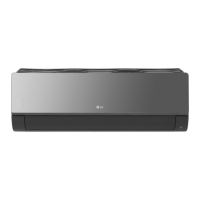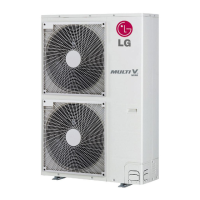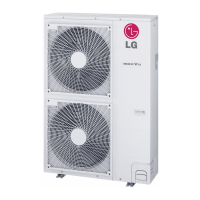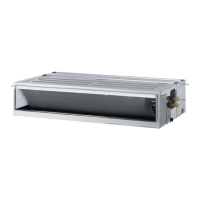40
Multi V Wall-Mounted Indoor Unit
Due to our policy of continuous product innovation, some specifications may change without notification.
©LG Electronics U.S.A., Inc., Englewood Cliffs, NJ. All rights reserved. “LG” is a registered trademark of LG Corp.
REFRIGERANT PIPING
Piping Preparation
1. All joints are brazed in the field. Multi V refrigeration system components contain very
small capillary tubes, small orifices, electronic expansion valves, oil separators, and
heat exchangers that can easily become blocked. Proper system operation depends
on the installer using best practices and utmost care while assembling the piping system.
2. Store pipe stock in a dry place; keep stored pipe capped and clean.
3. Blow clean all pipe sections with dry nitrogen prior to assembly.
4. Use adapters to assemble different sizes of pipe.
5. Always use a non-oxidizing material for brazing. Do not use flux, soft solder, or anti-
oxidant agents. If the proper material is not used, oxidized film may accumulate and clog or damage the compressors. Flux can harm the
copper piping or refrigerant oil.
6. Use a tubing cutter, do not use a saw to cut pipe. De-bur and clean all cuts before assembly.
7. Brazing joints:
• Use a dry nitrogen purge operating at a minimum pressure of three (3) psig and maintain a steady ow.
• Use a 15% silver phosphorous copper brazing alloy to avoid overheating and produce good ow.
• Protect isolation valves, electronic expansion valves, and other heat-sensitive control components from excessive heat with a wet rag or
heat barrier spray.
Figure 33: Refrigerant Pipe Brazing.
Valv
Valve
Taping
Nitrogen
Pipe to
be brazed
Piping
Brazing Procedure
Do not braze in an enclosed location. Do not allow the refrigerant to leak during brazing. Always test for gas leaks
before and after brazing.
If the refrigerant combusts, it generates a toxic gas the may cause physical injury or death.
Braze the pipes to the service valve pipe stub of the outdoor unit.
• Do not allow the refrigerant to leak during brazing; if the refrigerant combusts, it generates a toxic gas. There is risk of re, explosion,
and physical injury or death.
• Do not braze in an enclosed location, and always test for gas leaks before / after brazing. There is risk of re, explosion, and physical
injury or death.

